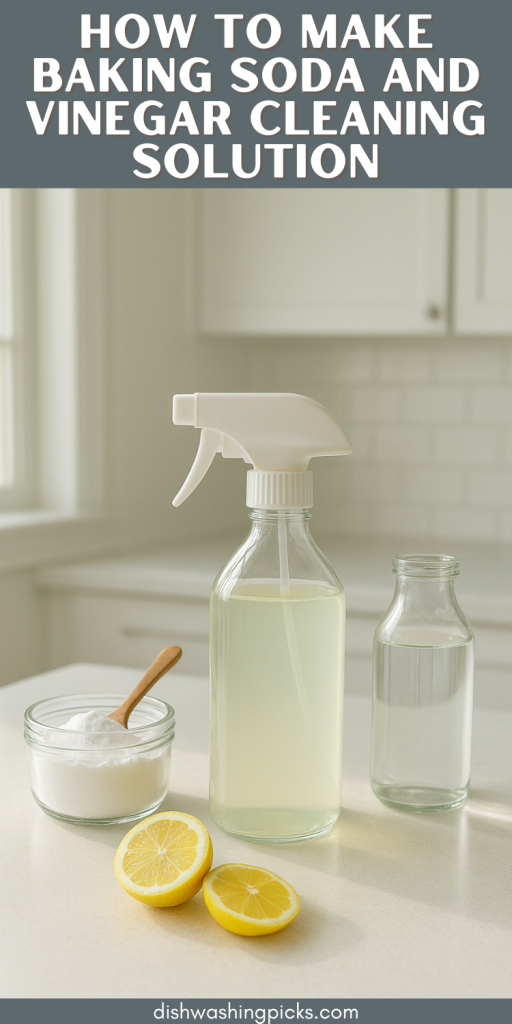
The Dynamic Duo of Cleaning
If cleaning products had a celebrity couple name, baking soda and vinegar would definitely be it. They’ve been around forever, they work well together, and honestly—they’re kind of iconic.
Think about it: baking soda is the gentle scrubber, the odor-fighter, the team player. Vinegar is sharp, acidic, and doesn’t mess around when it comes to cutting through grime. Put them together, and you’ve got a fizzing reaction that feels like science class and spring cleaning rolled into one.
But here’s the kicker—most people know of this combo, yet very few actually know how to mix and use it the right way. That’s where we’re headed.
Why This Combo Works (Science Without the Boring Bits)
Okay, quick nerdy moment—don’t worry, no test at the end.
- Baking soda is a mild alkali. That means it can dissolve dirt and grease in water. Plus, it’s slightly abrasive, which makes it great for scrubbing without scratching.
- Vinegar is acidic, and acids are amazing at breaking down mineral deposits, soap scum, and sticky messes.
When they meet, they fizz like a volcano project from middle school. But here’s the important part: that fizzing doesn’t magically dissolve dirt—it just helps lift grime, break down residues, and make scrubbing easier. So the real magic is in how you use them, not just in mixing them.
What You’ll Need
No complicated shopping trips here. You probably already have these sitting in your kitchen:
- Baking soda (good ol’ sodium bicarbonate)
- White distilled vinegar (cheap, effective, no fancy brands required)
- Warm water
- A spray bottle or bowl (depending on how you want to apply it)
- A sponge or cloth for scrubbing
Optional: A few drops of essential oil (like lemon or lavender) if you don’t want your place smelling like a pickle jar.
The Recipe: Mixing It Up
Alright, let’s get practical. Here are a couple of simple ways to make your cleaning solution, depending on the job:
For General Cleaning Spray:
- Fill a spray bottle with 1 cup of vinegar and 1 cup of water.
- Add 1–2 teaspoons of baking soda (do this slowly—it’ll fizz!).
- Wait for the bubbles to settle, then screw on the top.
- Shake gently before each use.
For Tougher Jobs (like drains or soap scum):
- Sprinkle baking soda directly on the area first.
- Spray vinegar over it and let it fizz for a few minutes.
- Scrub with a sponge and rinse with warm water.
That fizzing action? That’s your “pre-scrub” working for you.
Where to Use It (and Where Not To)
So, where does this solution shine?
Great for:
- Kitchen counters (non-stone)
- Sinks and faucets
- Glass and mirrors
- Showers and tubs
- Deodorizing drains
Skip it on:
- Natural stone (like granite or marble—the vinegar can etch it)
- Hardwood floors (the acidity can damage the finish)
- Electronics or screens (keep liquids far away from those)
Think of it like a superhero with limits—it’s powerful, but you don’t want it fighting battles it wasn’t meant for.
Pro Tips for Best Results
- Always make small batches. The fizzing power fades over time, so fresh is best.
- Test on a small hidden area first if you’re unsure about a surface.
- If you hate the vinegar smell, don’t worry—it usually disappears once it dries. Or add those essential oils for a fresh twist.
- For drains, try pouring a kettle of boiling water after the baking soda and vinegar fizz—extra cleaning power!
Cleaning Doesn’t Have to Be Complicated
At the end of the day, baking soda and vinegar are proof that you don’t need a shelf full of expensive sprays to get your home sparkling. With just two pantry staples, you can tackle grease, grime, and odors in a way that feels simple and—dare I say—satisfying.
So next time you’re standing in the cleaning aisle debating over a $12 “miracle spray,” remember: the real miracle might already be sitting in your kitchen. Give it a try, watch the fizz, and enjoy that oddly satisfying feeling of cleaning like a pro with the simplest ingredients.
